
It’s completely normal for siblings to have to share a room, at least for some period of time anyway. Most of us have been there at some point. But the design, decor and layout of the shared room can either really enhance the experience or make it pretty unbearable for your children. That’s why we’ve put together these clever kids’ shared bedroom ideas to help you achieve the former for your little ones and, by extension, for you too.
The wrong children’s room ideas can lead to anything from an impractical layout that doesn’t work, a cluttered look and feel or an uneven split of the space which can lead to arguments and fights between your kids, rather than harmonious cohabitation.
On the other hand, getting this right will give both of your kids a level of privacy, their own space that they feel is truly theirs and is of equal size to their sibling, as well as space that’s shared and where they can spend time together. It’s all about striking a balance between the two here.
Kids' shared bedroom ideas
‘In a shared kids’ bedroom, layout is everything,’ says Chloe Barrow, interior expert at Laura James. ‘I always start with zoning areas for sleeping, playing, and studying.’
But we’d add that it’s also about the right children’s bedroom furniture choices – so be cautious when investing in these as they can either make or break the room.
1. Add a shared reading nook
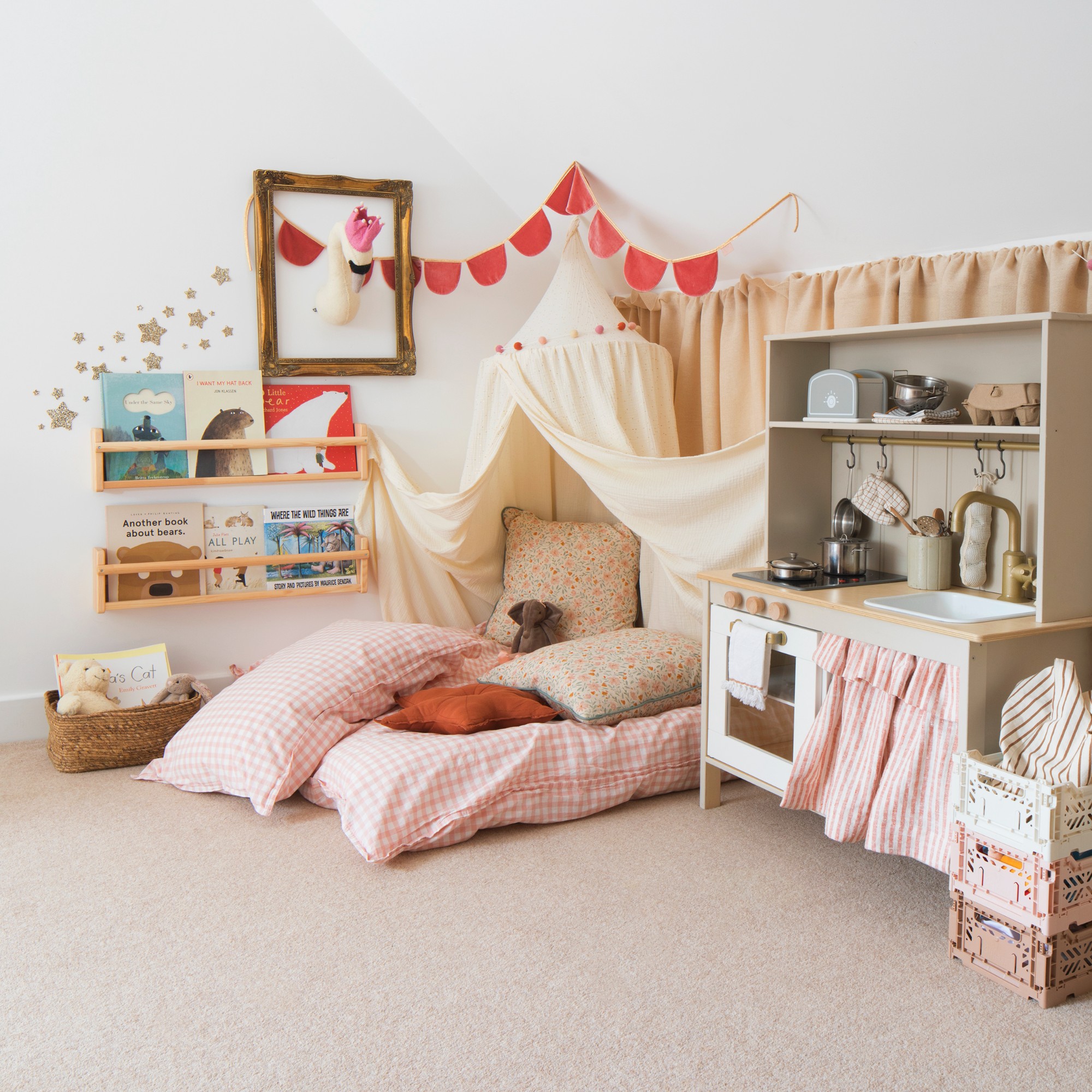
Reading corner ideas are perfect for a kids’ room – and it’s also the ideal opportunity to create a space that’s meant to be shared between the siblings where they can also spend time together. And all that's needed to create one are some cushions and/or pillows and potentially a canopy like this Wonder Space one from Amazon to recreate the look from the image above.
‘The centre of the room could be perfect for a shared reading nook, creating a space that promotes togetherness instead of competition,’ says Sienna Brooks, Flitch interior stylist.
2. Use a bookshelf for partition
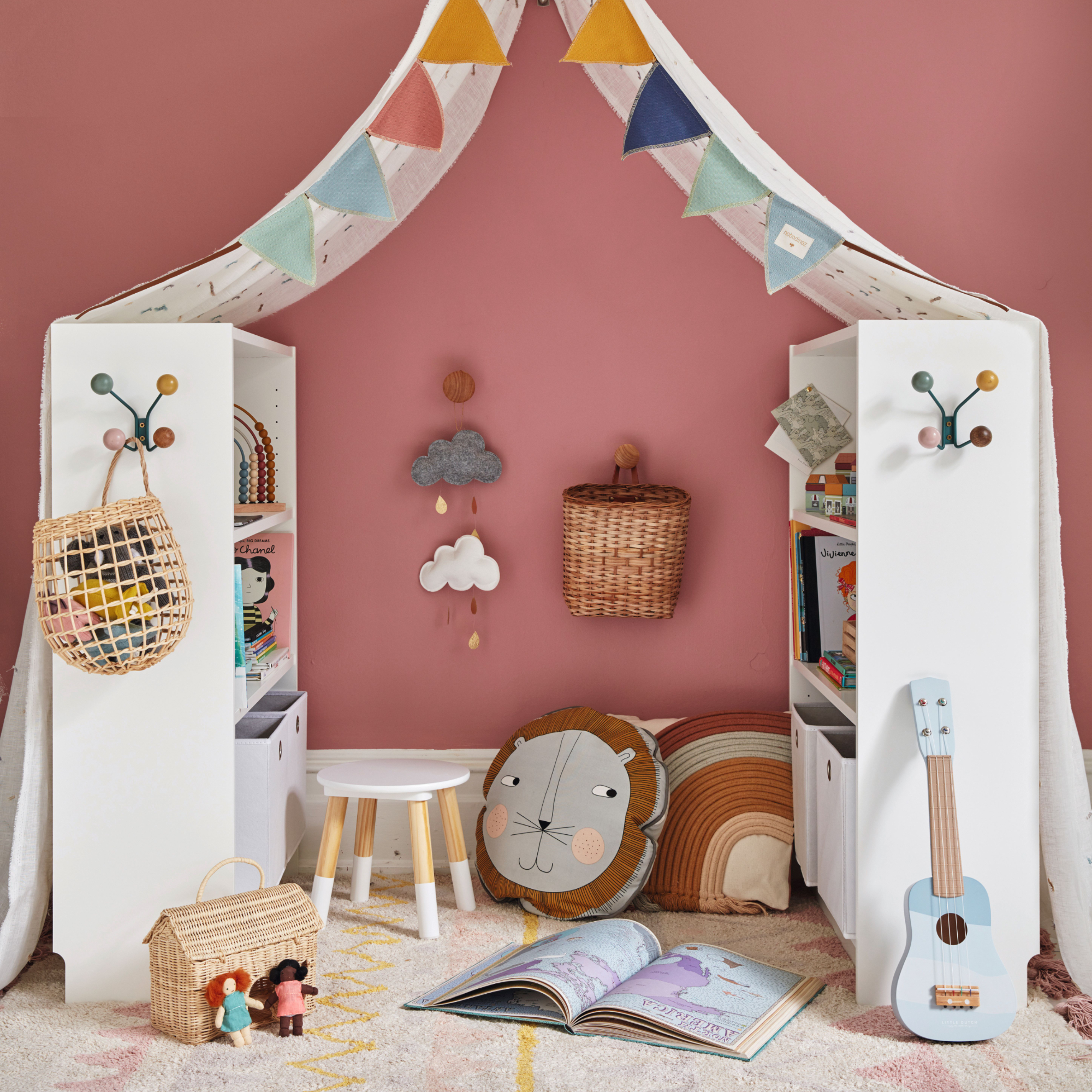
If you want to create a physical separation between the two areas, each belonging to one of the kids, then rather than installing something not dissimilar from a wall, go for something that will still allow light to come through.
‘Instead of going for solid partitions, consider using a half-height bookshelf or a curtain hung on a tension rod. This way, each child can have their own little space without cutting off light or airflow,’ Sienna at Flitch says.
3. Maximise space with clever storage

As the room is designed to serve more than one person, it’s safe to assume that space is considered luxury – so make the most of every inch, including the vertical ones.
‘Think vertical. Tall bookcases, under-bed storage drawers and wall-mounted desks are fantastic for keeping the floor clear for playtime. Don’t overlook the back of the door either. Over-door organisers can be a game changer for storing toys, shoes or even homework supplies,’ Sienna at Flitch advises.
Chloe at Laura James agrees, ‘Maximising space always comes down to how well you use height. Bunk beds remain my favourite for good reason, but if that’s not right for your family, then focus on the wall space you have. Shelving, hooks, hanging storage and even wall-mounted desks help keep the floor clear for play are great options.’
4. Go for a high sleeper
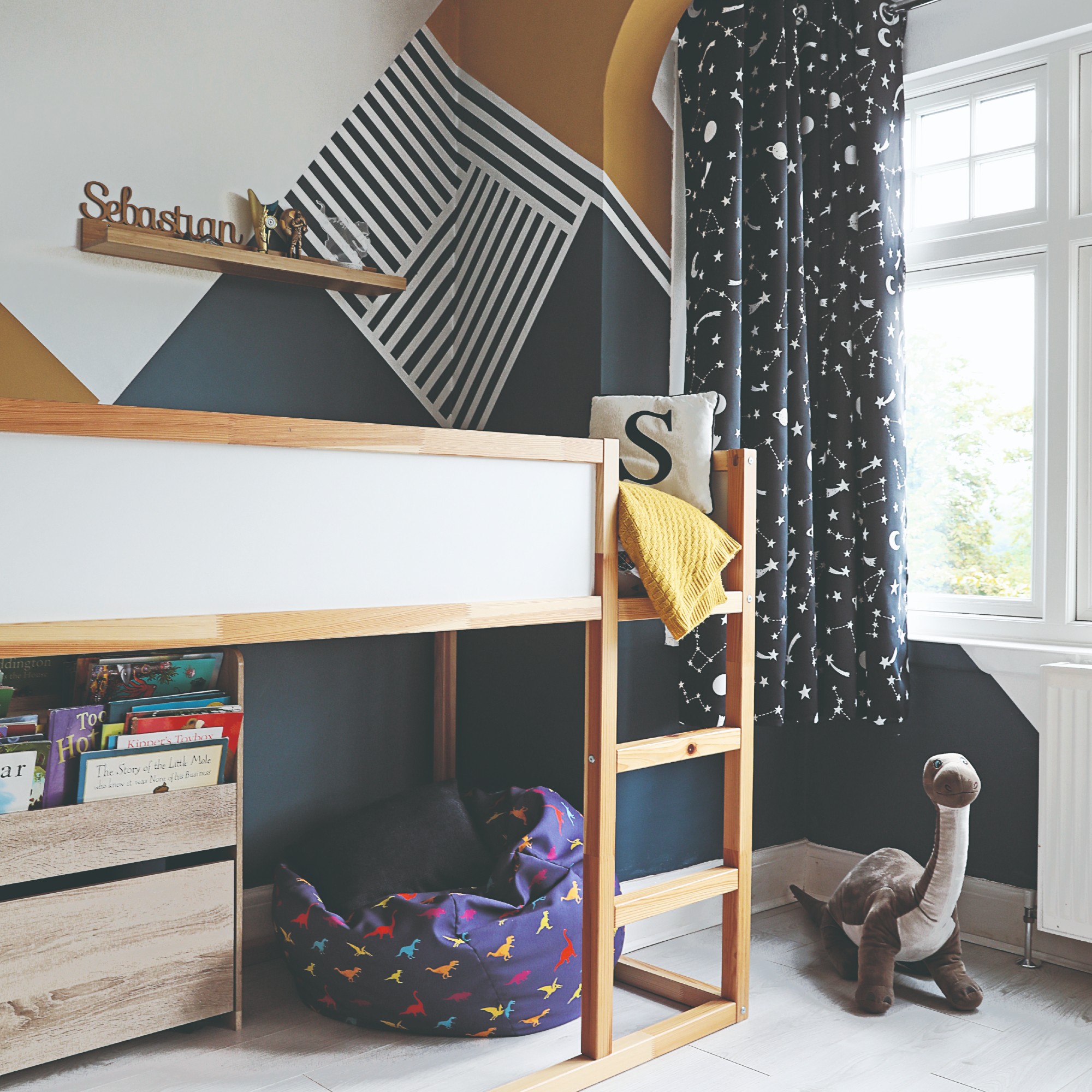
If there’s enough space for two separate beds rather than bunk beds, then you can opt for high sleepers like the Habitat Ronnie design from Argos which will then create extra space underneath the beds for each of the kids to enjoy for either play or homework, or both.
‘If space allows, the best solution can be placing raised beds on opposite sides of the room. This will help create natural separation and a sense of ownership for each child. These beds can allow for a play space and desk area underneath. This not only maximises height but also gives each child a sense of privacy within their own mini zone,’ Chloe at Laura James explains.
5. Divide the space equally
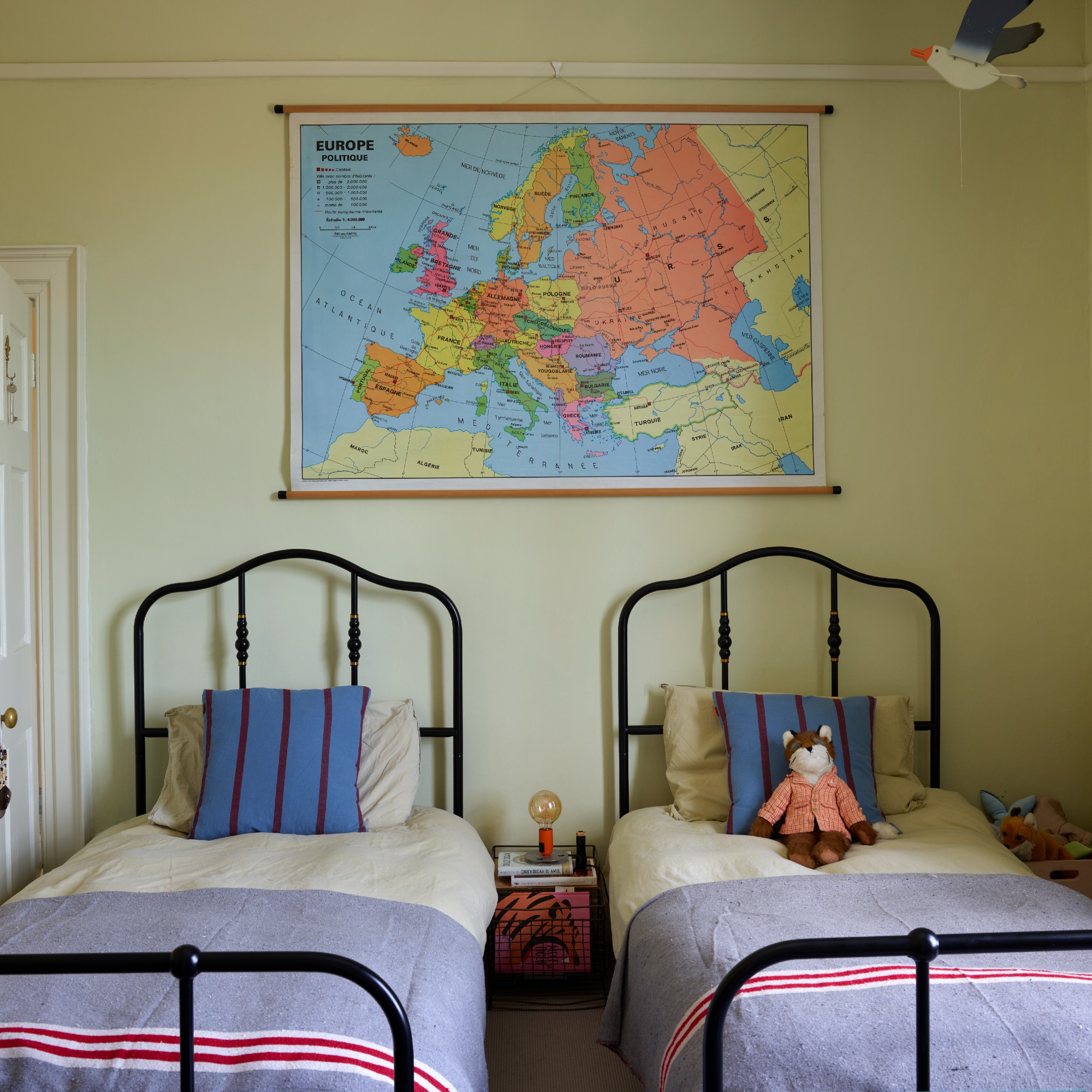
Treating children equally will diffuse resentments before they start. So ensure each child has the same amount of space, regardless of age or other factors.
If you're including beds with built-in storage beneath, make sure you know which side the drawers will open. It will reduce any arguments and make life easier if drawers can be opened without encroaching on each other's space.
6. Include built-in storage where possible

Kids accumulate a lot of 'stuff'. From clothes and shoes, to toys, books, sports kids, dressing up costumes, school work and more. With two kids sharing a bedroom, it's easy for things to get out of hand, particularly when they grow out of things so fast.
They key to keeping things organised and under control is ample storage. Built-in or bespoke options will make the most of every centimetre. So it's well worth considering the extra expense, especially in an attic bedroom or one with with awkward corners and angles. If you can stretch to the initial outlay, it will pay off in the log run, as it won't be necessary to replace small freestanding pieces with larger ones down the line.
Make sure drawers and cupboard space are divided up, so each child knows which is his or her section and they can find their own stuff. Some shared areas may be necessary for toy storage ideas, so ensure they are aware of this, with labels if necessary.
7. Choose a calming colour scheme
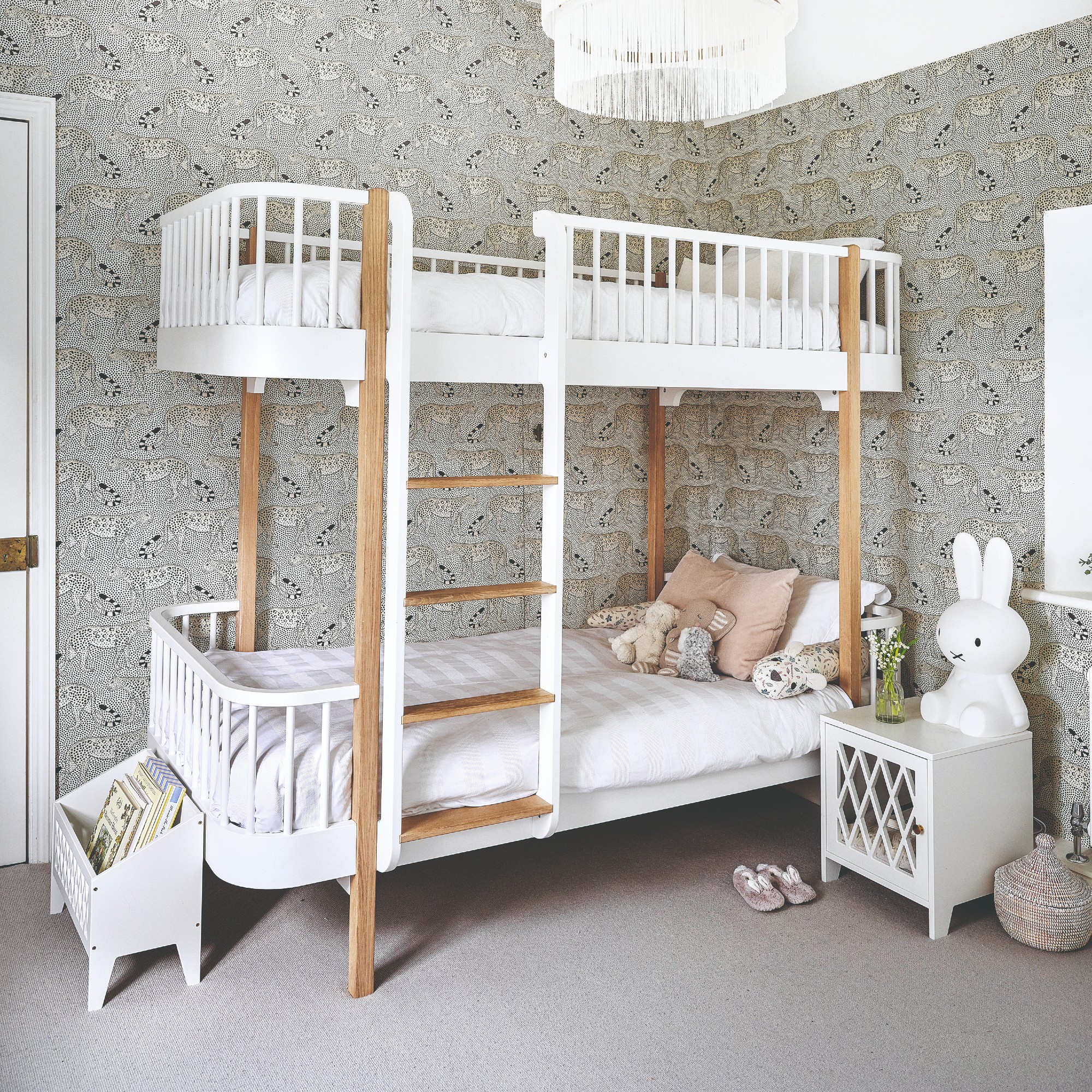
Colour affects our mood and how we feel, so to keep kids feeling calm, avoid a sensory overload of garish primary colours in their bedroom. Toys, books and games will keep them stimulated, so it's good to temper this with a backdrop of serene neutrals and gentle pastels in their space.
'Personality can be added without altering the décor through photographs and other items being hung on the wall,' says Georgia Metcalfe, founder of The French Bedroom Company. 'Remember, plain walls and furniture don’t go out of style and make a room feel bright and airy.'
This is a smart solution in a girl's bedroom idea if you're dealing with two very distinct personalities. The calming neutral scheme will be the perfect backdrop for both to express themselves.
8. Be inventive with a bunk bed layout
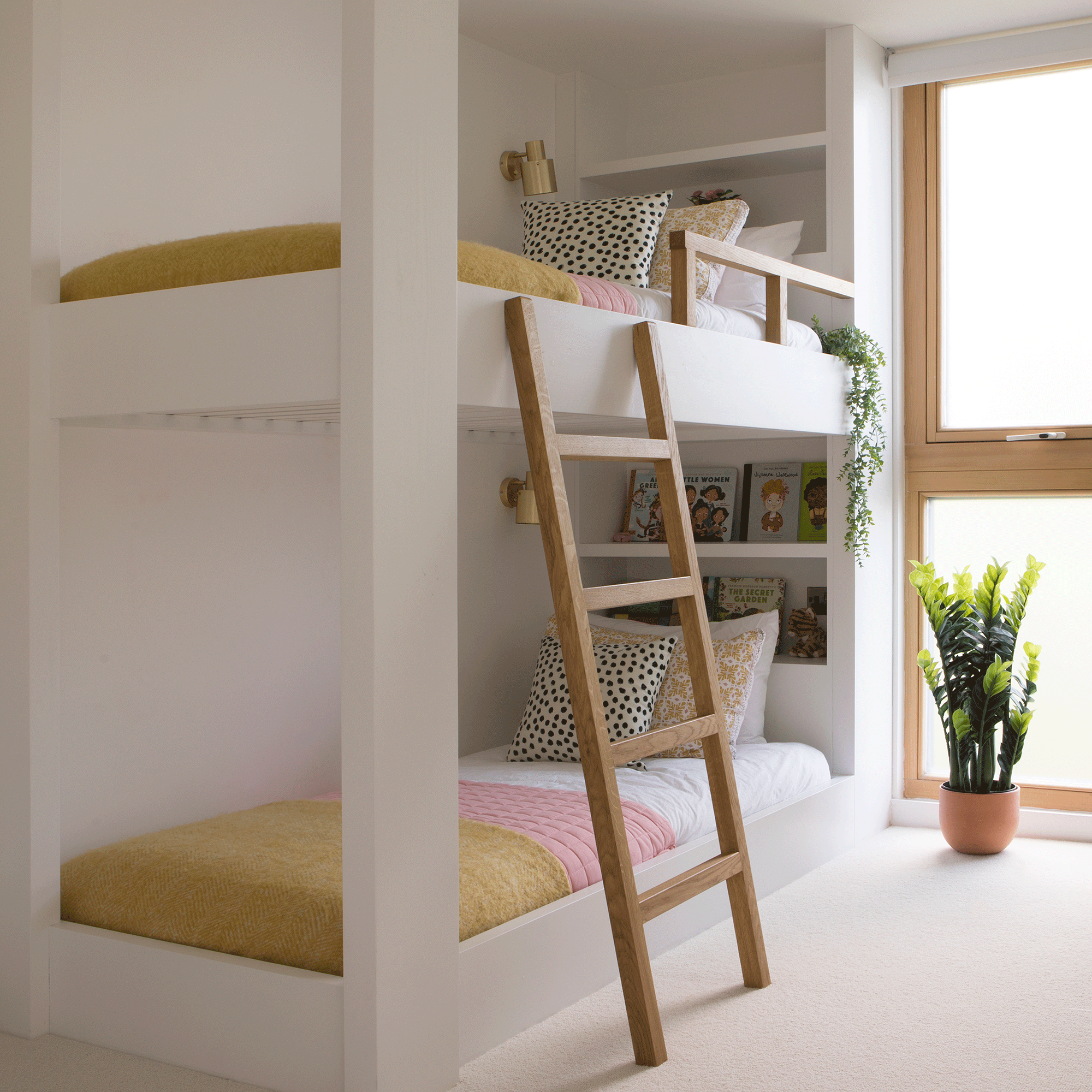
Of course, the traditional bunk bed layout is a well designed way to accommodate two kids in a small bedroom. However, it may not work so well for kids of different ages, where their needs vary.
If you have a younger one who still likes bedtime stories and you want to be able to pull up a chair next to the bed, consider an alternative bunk bed layout. This can either be done by an choosing L-shaped model like the Horizon Bunk Bed Frame from Dunelm or with a platform bed and a single bed at a 90 degree angle beneath, instead of a desk setup.
9. Make learning fun with a double desk
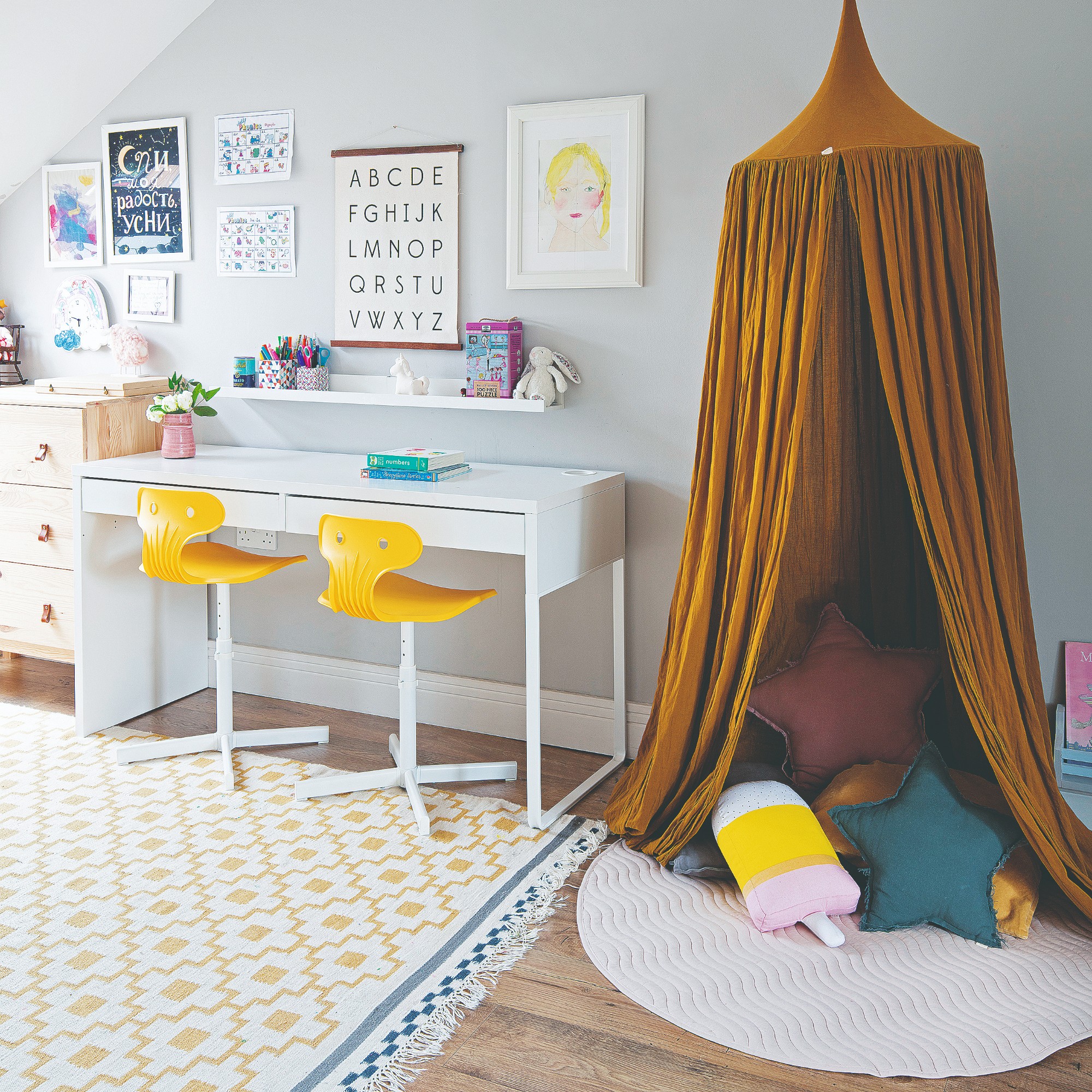
Provide kids with a smart and stimulating shared place to do homework and they'll be more likely to knuckle down and do it. This is particularly essential for teenage bedroom ideas if they have exams coming up.
Creating an alcove beneath built-in storage is an ideal spot for a double desk. Ensure there's enough space for both kids to sit and write, draw or do their homework at the same time. And make it fun, with quirky wallpaper that can be coloured in to encourage their creativity when they study alone too.
10. Go for a theme they'll both love

Accommodating colours, patterns and themes each kid loves can lead to a messy mishmash of a shared bedroom scheme that suits neither them nor you.
Instead, go for a theme, such as a movie, book, topic or character that they both enjoy and make that the focal point. Setting this within a neutral background will allow each child the space to personalise their section of the bedroom with favourite toys and teddies.
11. Make bedtime appealing with modern design

If bedtime in a shared bedroom turns too easily into bickering or play time, make it more appealing with a cocooning modern bunk bed design.
With shelves that can be personalised and its cosy rounded shape, this bunk bed feels more like a den or a place to hang out, where each kid gets their own space to read and relax before lights out.
12. Pick furniture that will last
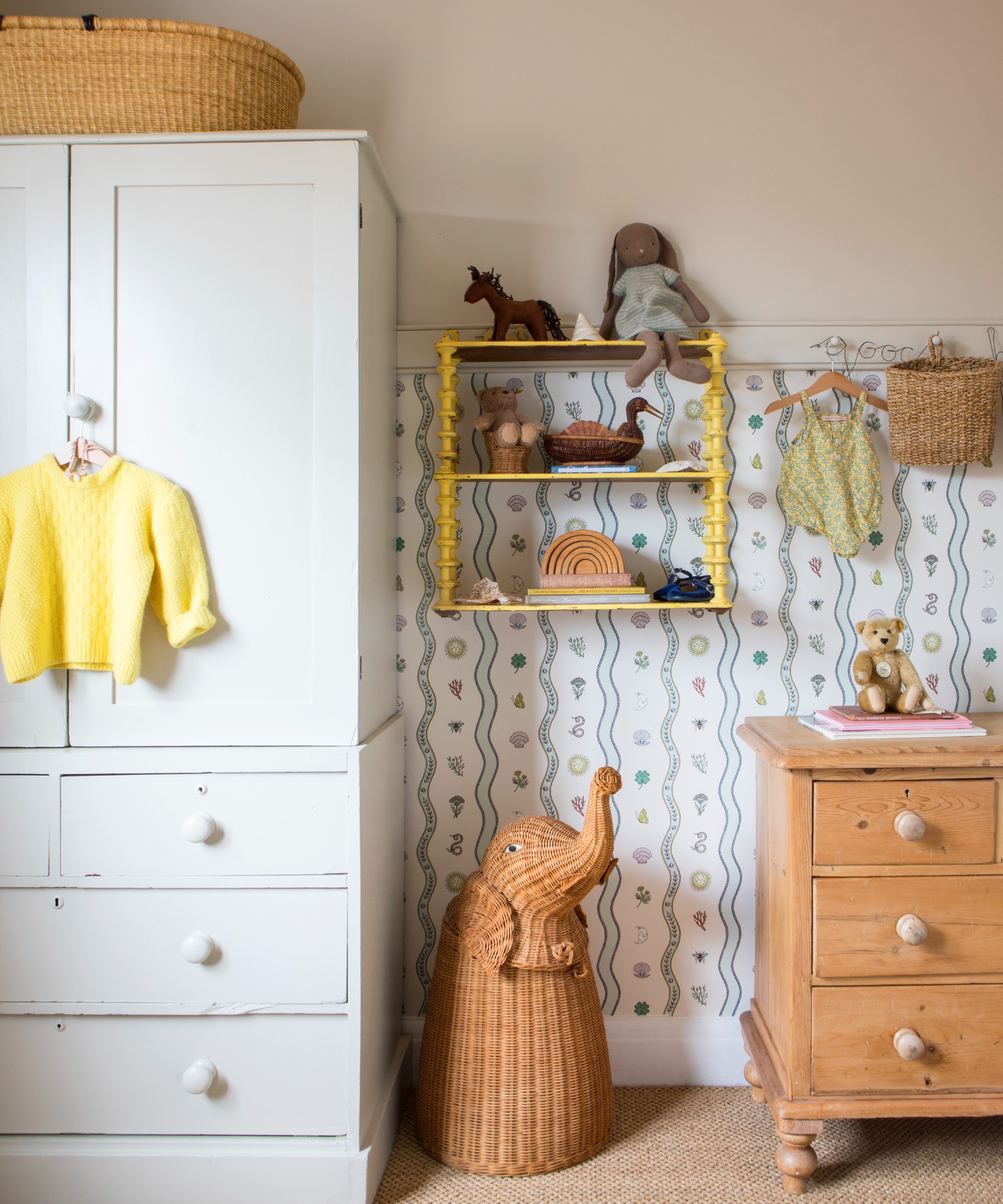
Vintage pieces by their nature have weathered the years and various design trends. These make a good choice if you want what the furniture you choose to see your little ones through from toddlers to teenagers. Home furnishing discount codes is another thing to bear in mind to help you pick up the pieces you want without breaking the budgets.
'To prevent frequent furniture replacing, purchase durable pieces that will stand the test of time,' says Georgia from The French Bedroom Company. 'Wardrobes, tables and chests of drawers are key choices. Solid craftsmanship in the design and natural materials are generally a good indicator that the furniture will last.'
13. Include space for soft play areas
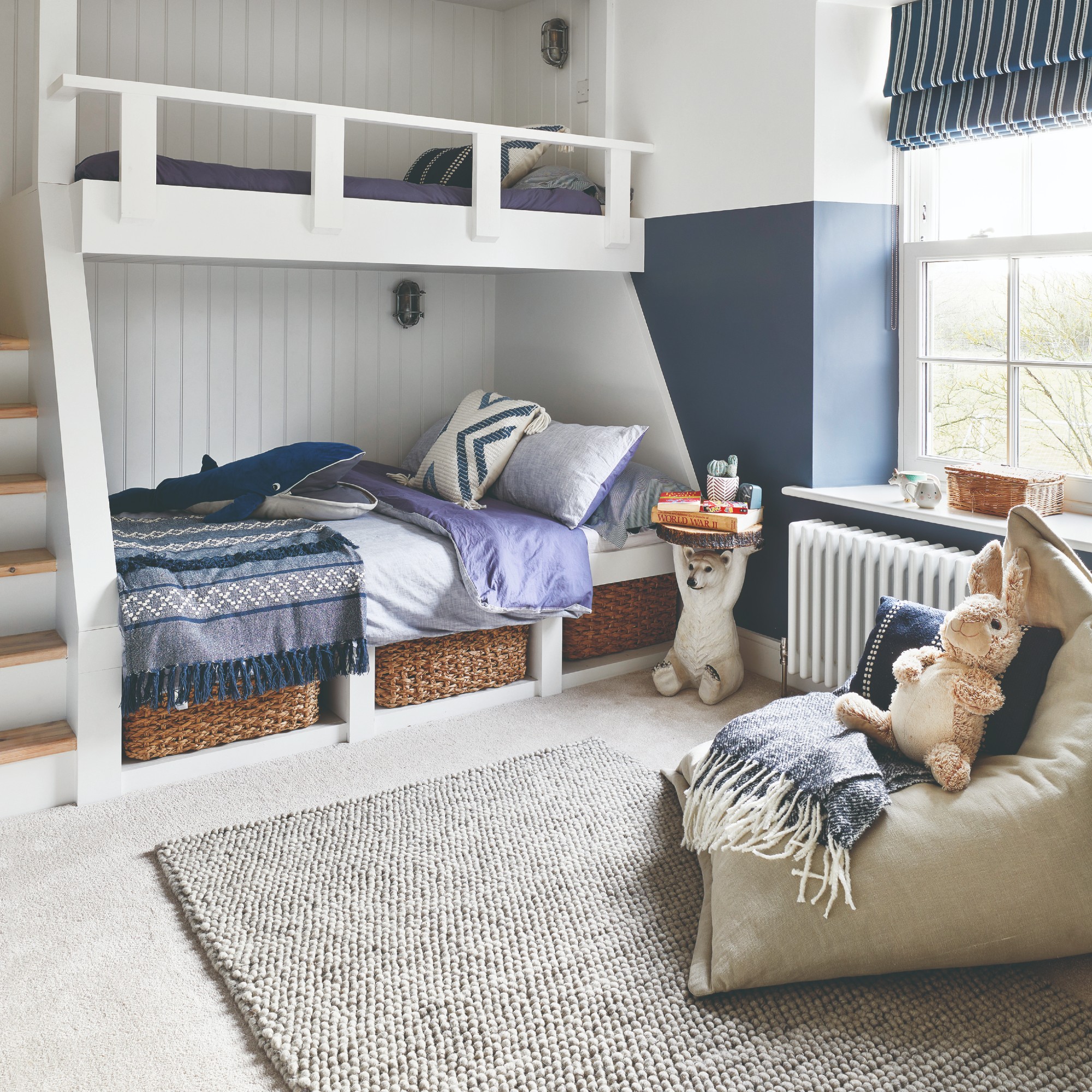
Kids love to play on the floor, so whether you've gone for carpet, timber flooring or a fun rug like this transport-print one from Habitat, ensure you include a section of floor space for them to play. Ample storage nearby and extra rugs underfoot for their comfort will encourage this.
'Children's rooms can be short on space, so it's vital to get smart with the layout to maximise what's available,' says Christopher Lusty, founder of Little Folks Furniture.
'Having simple ways to declutter and create floorspace is fundamental to maintaining a harmonious bedroom. Raised bed frames give the option to tuck storage underneath.'
14. Paint the walls with multiple colours
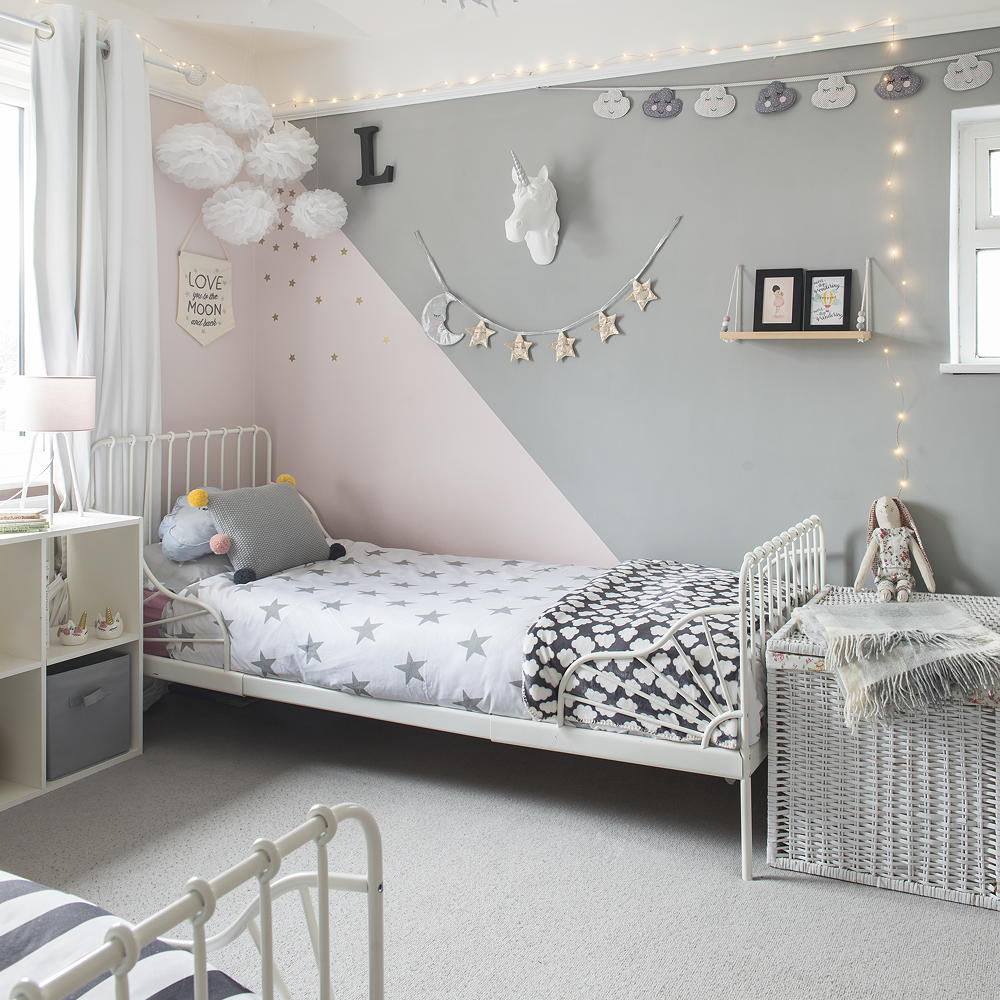
If one child is begging for pink walls and the other wants a contrasting colour why not blend both their choices together, creating a colour scheme that keeps them both happy. Rather than painting each wall a different colour why not create a funky geometric design on the walls with the two colours?
Create this diagonal design by running masking tape down the wall to create a sharp line between the different coloured bedroom paint ideas. Finish off the room with room decorations that will appeal to both kids.
15. Break up the conventional layout
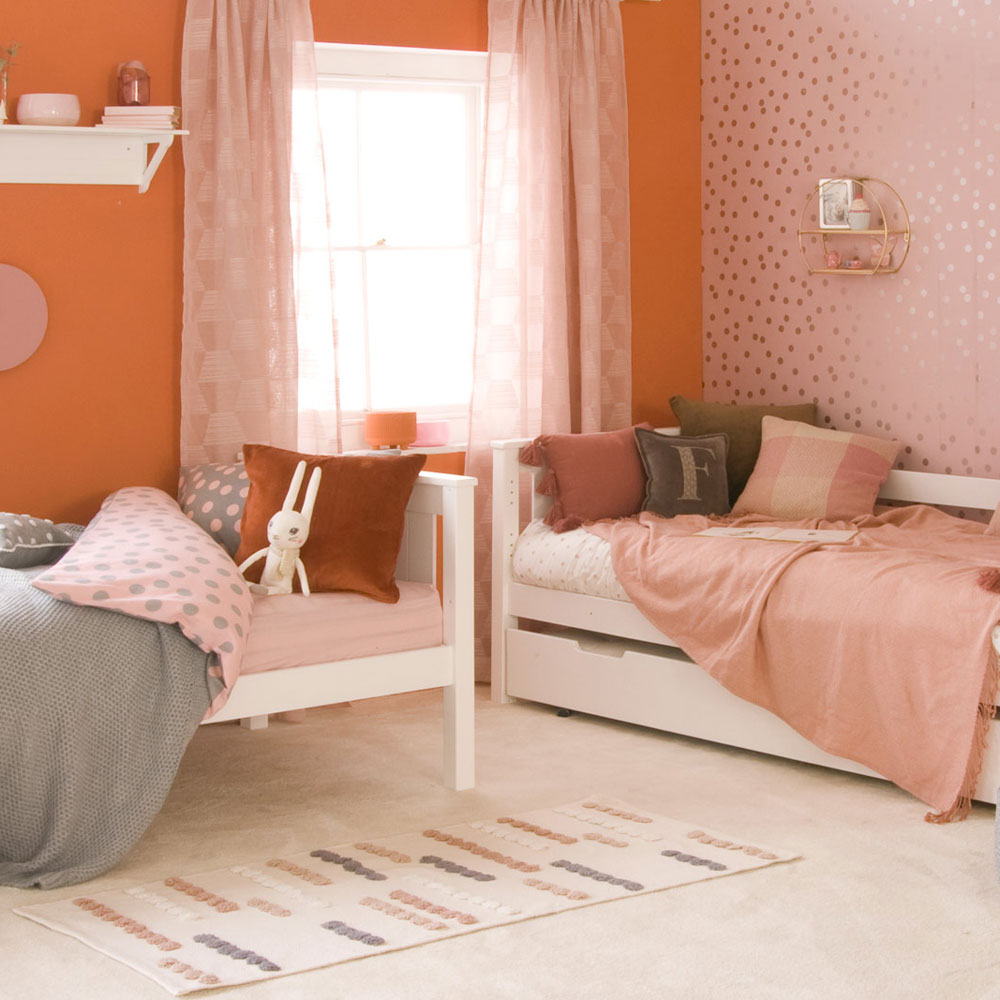
Don't feel like you have to conform with the traditions of having symmetry when it comes to how to divide a kids room bedroom. In fact, mixing up how to arrange furniture in a bedroom can make a big impact on the rooms layout. Rather than seeking symmetry to zone the room for each child the beds are placed almost back to back to dominate one corner – freeing up the rest of the space for their individual needs.
Having the beds facing away from each other helps to give each child a different persecutive, a wall to call their own.
16. Mix and match individual styles
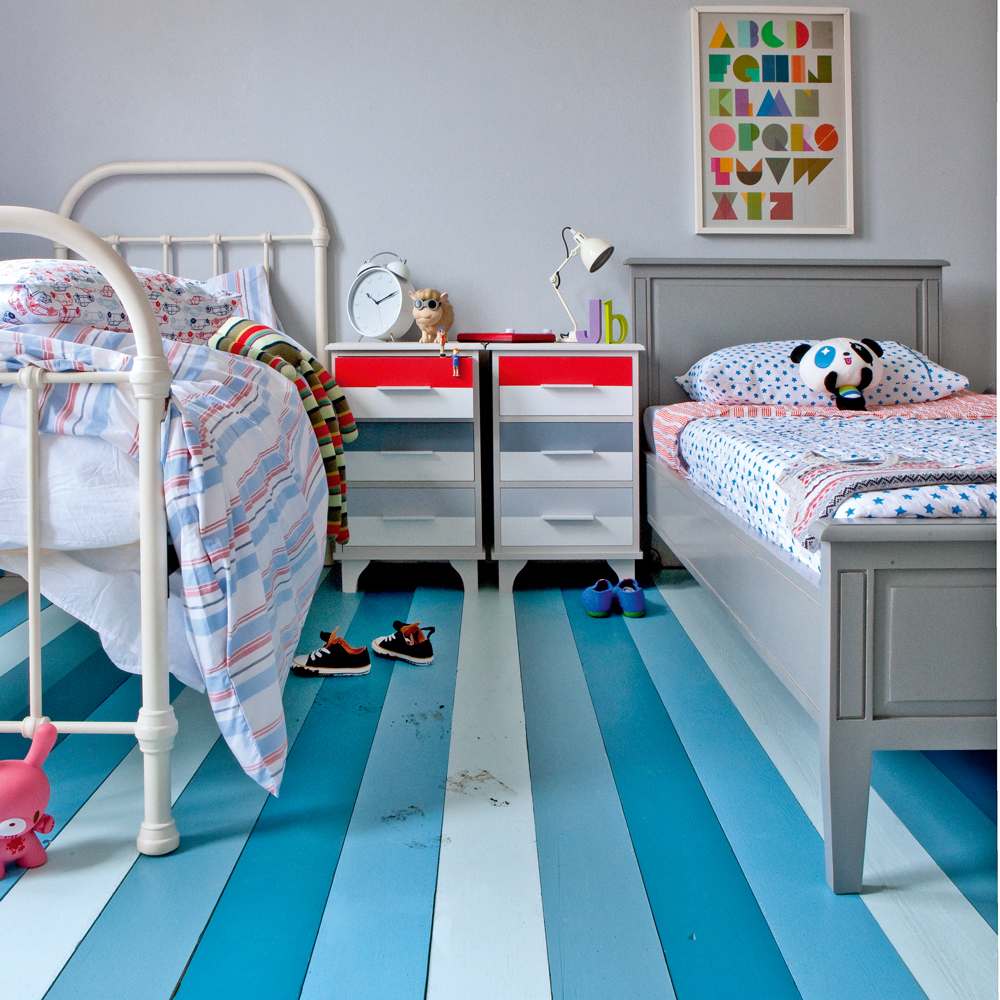
Your kids may have to share a room, but that's as far as it has to go. If you have one messy, one tidy, one boy, one girl, one explorer and one ballerina then fill the room with different room accessories and bedding.
Although it's within shared bedroom ideas you can even go as far as giving them completely different beds and desks, don't deny them their own style just because they share the same room.
17. Welcome a feature wall for storage
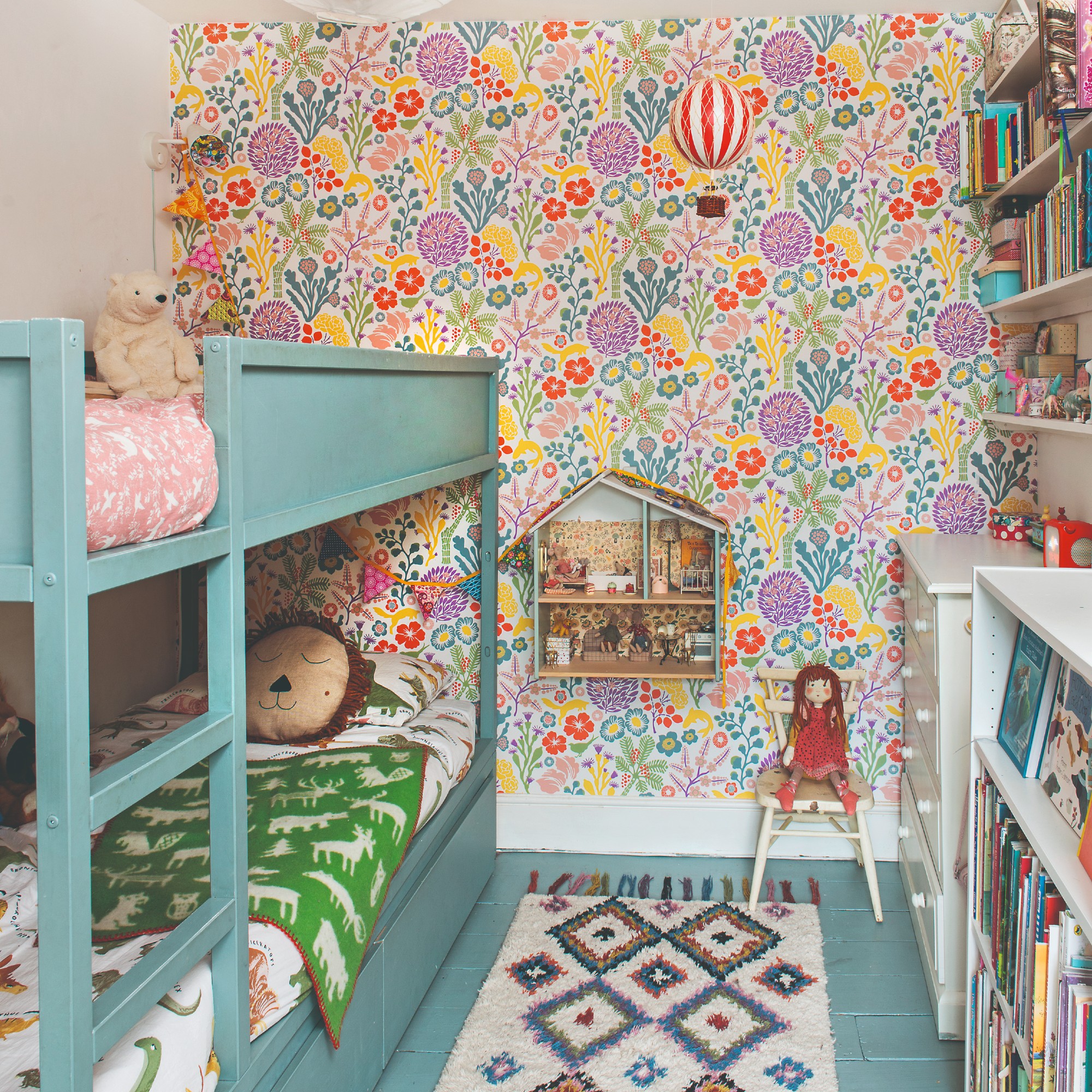
Balance a twin set up with a feature wall for toy storage ideas and bookshelves. The curated wall provides plenty of space for double everything, from baby toys through to artwork and more grown-up accessories.
If you've had baby twins then why not keep them together? At a young age, it doesn't matter if they're different sexes they can happily stay in shared bedroom ideas. Keep everything multicoloured in animal and alphabet designs which can be updated with pops of pink and blue if you wish.
18. Add one harmonious accent colour
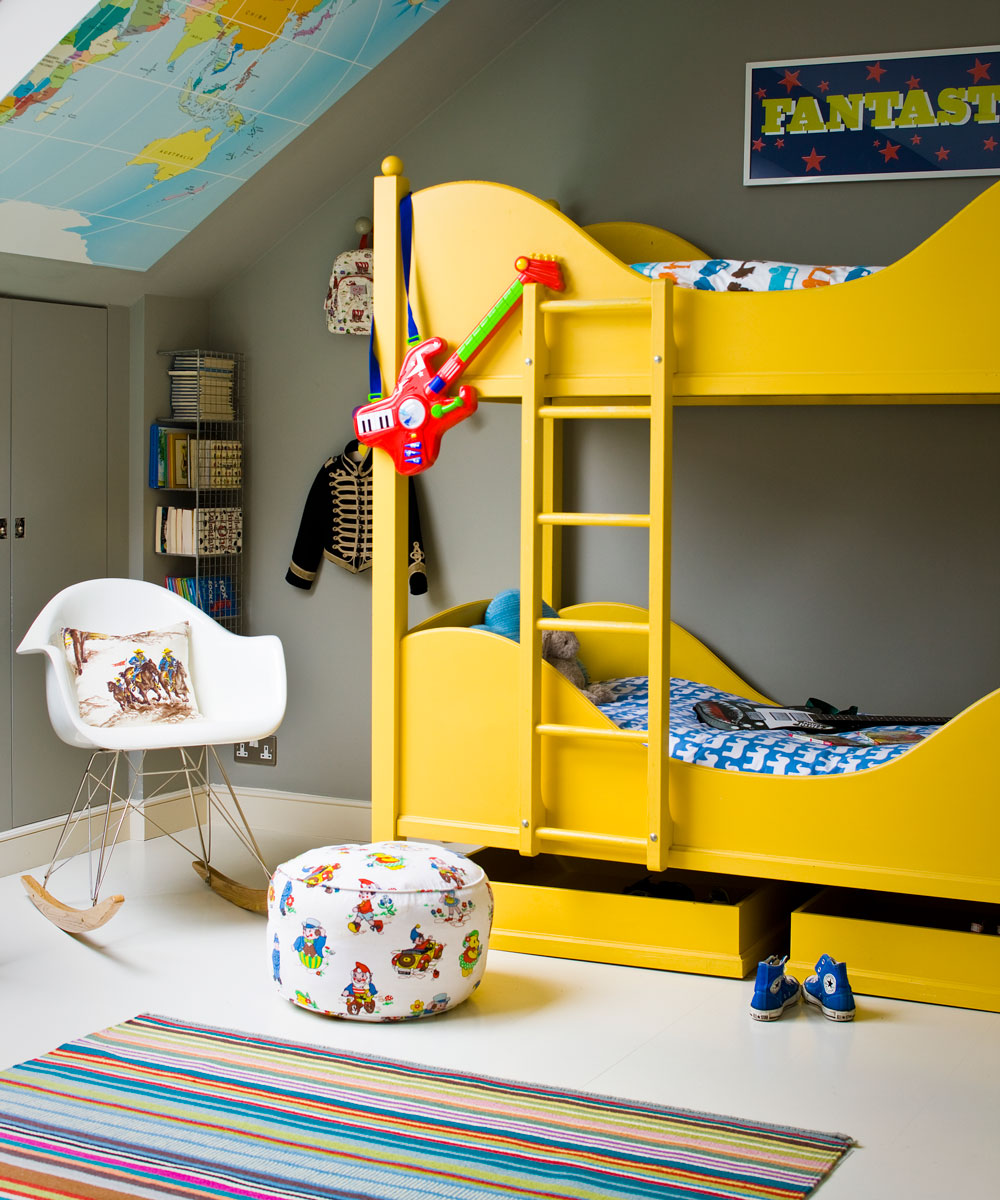
Inject a hit of colour that both children like, to add a harmonious accent colour. A colour such as brilliant yellow will prove timeless as they grow, meaning you won't need to refresh every year as they grow out of baby pink or baby blue.
Paint window shutter ideas in a striking shade to invigorate the room and highlight the view beyond – encouraging them to look out to a world beyond those four walls.
19. Personalise everything

So you don't get into ‘but that's mine' arguments, personalise everything where possible. Fun bedroom wall decor, bedding embroidery and even painted name signs like this Etsy one placed above each of their beds are all great ways to show the divide in the room, whilst keeping everything else the same.
In shared bedroom ideas, you do run the risk of siblings feeling like they're unable to express themselves, but with personalisation they can literally stamp there name on everything.
20. Add extra privacy with a tent

Every child loves a den but it is a clever addition to a shared bedroom. They can choose to play in the tent together or use it as a space to get away from each other. You can buy indoor children's tents online, or make one yourself that will fit perfectly into the corner of the room like this one.
This bedroom tent is as simple to create as hanging a sheet over a pole attached to the ceiling and securing it to two point son the wall. All that's left is to fill it with a cosy rugs and cushions.
21. Create storage for both bunk bed levels
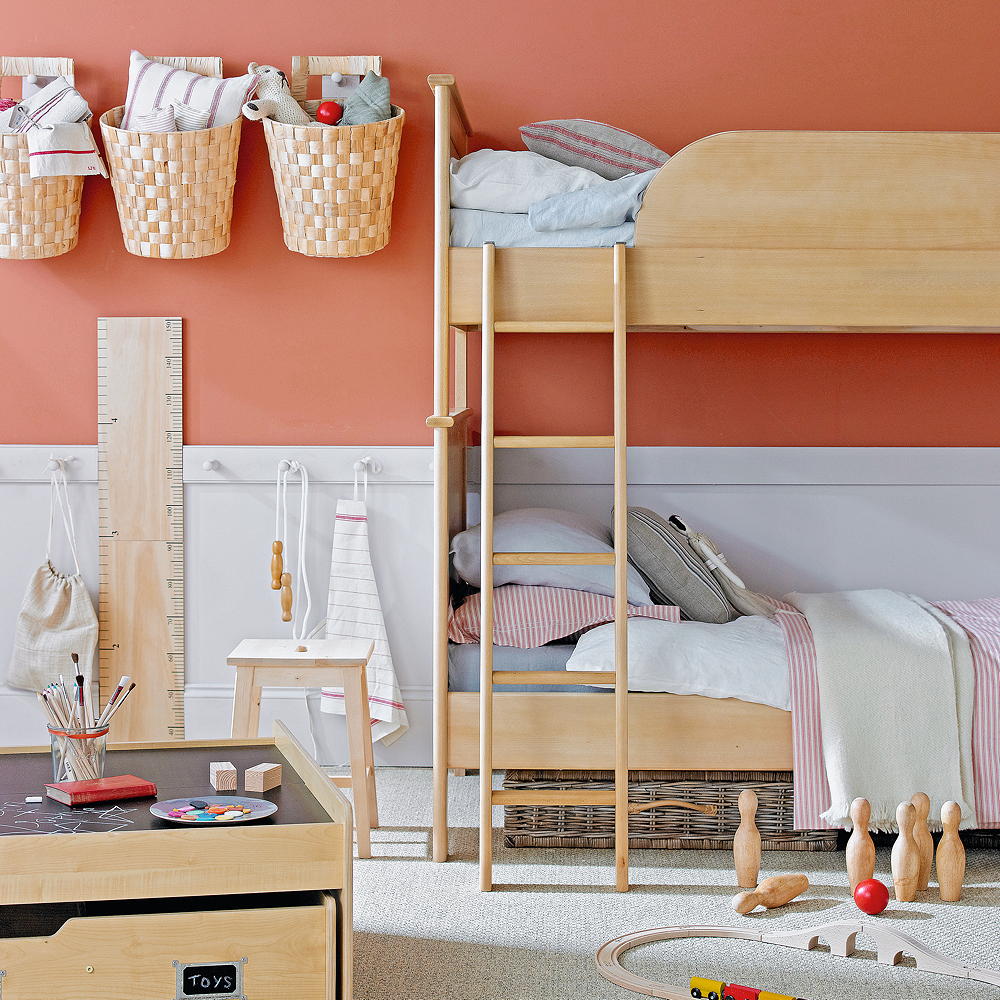
The storage for traditional bunk beds is usually found on the bottom level under the bottom bunk. However, shared bedroom storage, even if your two kids are best friends, can be a recipe for disaster. Insert a peg rail next to the top and bottom bunk and hang storage baskets or bags over them like in this room.
This will help keep your kids belongs separate and within easy reach from their bed, just be sure they are within easy reach for you to take down incase you're called in for any lost plimsoll emergencies.
Whether it's to hang above a bed for some privacy or to create a cosy shared reading nook, you can't go wrong with a pretty canopy like this one.
An L-shaped bunk bed frame is ideal if you have kids of different age groups with one needing more of your attention than the other. And this Dunelm design looks very Scandi chic too!
If a play area is involved, a fun rug design is a must! We're currently obsessed with this budget-friendly road design from Habitat.
A high sleeper is the ideal space-saving solution, really taking advantage of all the vertical space available. Underneath, you can pop a desk, a chill-out area with a bean bag or a play area.
Personalisation will really make even the smallest of spaces feel like their own. Especially when it's as cute and thoughtful as this name sign with a jungle theme.
These low bookshelves are both super versatile and affordable at £25 a pop. They can provide budget-friendly storage, a base for a play den and/or create a partial space divide.
FAQs
How do I arrange a shared bedroom?
The most important element is to make it fair. Each child should have a similar amount of personal space and storage, as well as shared areas.
'Depending on their age, involve your children in the styling of their room by asking what they would like and listening to their ideas,' says Christopher at Little Folks Furniture. 'Help them think about what they use their room for and how best you can put that into action.'
How do you make a shared room fun?
A shared bedroom is generally fun for most young children; you've always got company and you get double the toys to play with.
To make the decor fun, consider a theme that they both love, for example a character from a book or film. If the age difference means their interests are too varied, pick something general and easy to achieve, such as a painting a mountain mural on a wall.
How do you split a small shared room?
The best way to divide a shared kids room that's on the small side is to seek smart furniture choices, such as bunk beds and stacked storage to utilise space.
When space is at a premium, it is key to make your furniture work harder. Choose multifunctional pieces to offer more potential. Single beds with drawer storage below, bunk beds with shelving incorporated, seating with space beneath to stash toys will all help keep chaos to a minimum.
Which one of these kids’ shared bedroom ideas are you looking to put to the test and incorporate in your little ones’ space?







